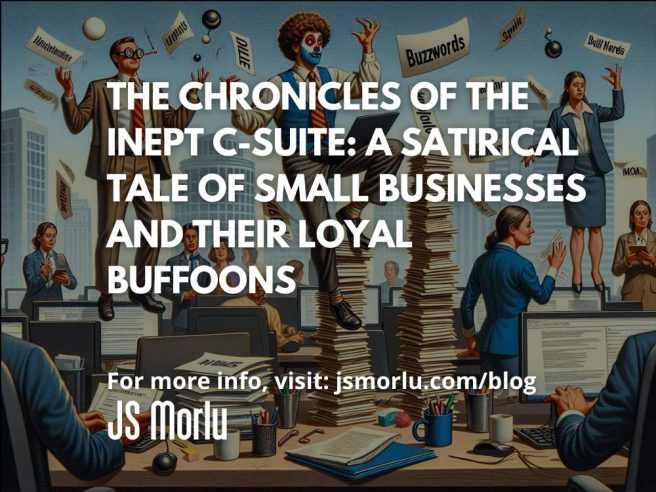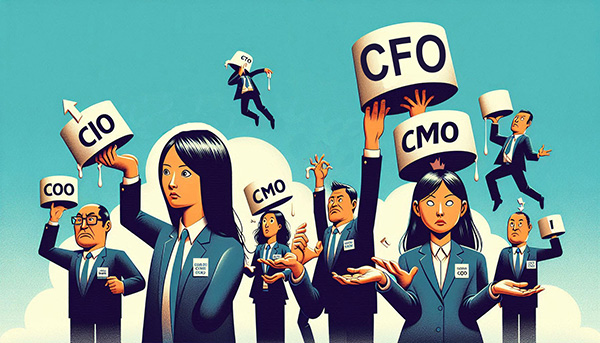By: John S. Morlu II, CPA
Introduction
Once upon a time in the bustling corporate landscape, a peculiar breed of professionals emerged: the highly-paid, impeccably dressed, and utterly ineffective C-level executives. These titans of nothingness occupied the highest echelons of the corporate hierarchy in organizations such as Sisyphus Solutions and Profit Blackhole Enterprises. With job descriptions that were vague at best and often just as confusing as a crossword puzzle in a foreign language, they donned impressive titles that obscured their ineffectiveness: CEO (Chief Evaporation Officer), CFO (Chief Fumbling Officer), and CMO (Chief Meme Officer).
These executives were not just any ordinary professionals; they were the custodians of corporate jargon, the overlords of buzzwords, and the champions of meetings that could have been emails. Their daily routines consisted of attending high-stakes conferences where they engaged in the art of networking—often defined as the ability to shake hands, exchange business cards, and discuss topics ranging from the weather to the latest trends in office coffee. Behind their polished exteriors lay a startling truth: many of them were little more than over-educated, under-skilled figureheads masquerading as leaders.
In this topsy-turvy world, actual productivity was as rare as a unicorn sighting. The executives at Sisyphus Solutions, for example, prided themselves on their ability to “think outside the box,” even when they often couldn’t find the box in the first place. They wielded phrases like “disruptive innovation,” “paradigm shift,” and “holistic integration” with reckless abandon, blissfully unaware that these terms often served to obscure rather than clarify. Their strategies, cloaked in layers of obfuscation, left their teams confused, unmotivated, and ultimately resigned to the realization that they were merely cogs in a machine that had long ceased to function effectively.
In this corporate fairy tale, we will delve deeper into the lives of these whimsical characters—exploring their eccentricities, the strange rituals they upheld, and the consequences of their misguided pursuits. Through the lens of humor and satire, we will unravel the common pitfalls that plague not only fictional companies like Sisyphus Solutions but also real-life organizations across the globe. From meetings that could have been succinct emails to grandiose plans that fizzled into nothingness, we will examine how the rise of these executive misfits has become emblematic of a larger issue in the modern business world.
Join us as we embark on a journey through the chaotic realm of C-level executives, where confusion reigns supreme, and the only true currency is the ability to appear busy while accomplishing nothing. Through their absurd adventures, we will uncover valuable lessons for small business owners, startups, and professionals seeking to navigate the often bewildering landscape of corporate leadership. The moral of the story? In a world where titles and appearances often trump actual skills and results, it’s time to shine a spotlight on what truly matters: effective leadership, genuine collaboration, and, above all, a commitment to fostering a culture of accountability and innovation.
Chapter 1: The Birth of Sisyphus Solutions: A Case Study in Futility
Sisyphus Solutions was the brainchild of a young, ambitious entrepreneur named Gary Optimystic. Like many startup founders, Gary harbored lofty aspirations and a burning desire to revolutionize the world of tech by selling… paperclips. Yes, you read that right—paperclips. Not just any paperclips, mind you. Gary was determined to create the world’s first AI-powered, blockchain-enabled, eco-friendly paperclips. You know, for the discerning environmentalist who believes in sustainability while organizing their paperwork.
After securing a whopping $15 million in venture capital (because apparently, the world was desperate for innovative paperclips), Gary decided it was time to build his dream team. Naturally, this meant hiring C-level executives who knew as little about paperclips as he did but could recite corporate jargon with the aplomb of a Shakespearean actor.
First on board was the ever-charismatic Chad Flexwell, the new CEO. Chad’s résumé was impeccable, boasting a long list of “disruptive” initiatives, none of which had ever actually disrupted anything beyond his last two jobs. His signature strategy was tossing around terms like “synergy,” “agility,” and “pivot” in every meeting, creating an atmosphere of confusion that could only be rivaled by a toddler trying to solve a Rubik’s Cube. Gary was mesmerized, convinced that Chad’s verbal gymnastics would magically translate into actual productivity.
Next came Pam Spendalot as CFO. Pam’s qualifications were astounding—she had a master’s degree in financial mismanagement and had previously worked at Budget Abyss Inc., where she spearheaded the company’s mission to creatively lose money. Pam had the unique ability to make a spreadsheet look like abstract art, complete with pie charts that resembled modern art installations. “It’s not about numbers; it’s about the story the numbers tell,” she would proclaim, leaving everyone wondering if the story was about bankruptcy or just a really expensive dinner party.
Rounding out this trio of terror was Trent TikTalk, the CMO, a self-proclaimed social media “influencer” with a following of at least seven people on Instagram (including his mom). Trent’s marketing philosophy was simple: post pictures of his breakfast and occasionally throw in a company hashtag. “This is how modern companies engage with their audience,” he assured Gary, while simultaneously taking a selfie with a paperclip that he’d strategically placed next to an avocado toast. The synergy was palpable!
And thus, the dream team was born. What could possibly go wrong?
The Synergy of Chaos
As the first week rolled into Sisyphus Solutions, the team gathered in the conference room for a brainstorming session—aptly named the “Synergy Summit.” The room was adorned with motivational posters featuring quotes like, “Dream Big—Even if It’s About Paperclips!” and “Fail Fast, Learn Faster!” It was clear that they were ready to conquer the world of office supplies, one flimsy metal clip at a time.
Chad kicked off the meeting by declaring, “We need to pivot our strategy to align our core competencies with the disruptive landscape of eco-friendly stationery.” Gary nodded along, fully convinced that these buzzwords were the secret ingredients to their success.
Pam then chimed in, “I’ve done a deep dive into our projected financials. While we might hit a small cash flow hiccup in the next quarter—let’s call it a ‘strategic liquidity pause’—we should focus on our long-term vision!” The team exchanged glances, unsure whether they were discussing paperclips or preparing for an impending financial apocalypse.
“Okay, team! Here’s the plan,” Chad said, “We’ll create a viral marketing campaign that showcases our paperclips as the essential tool for modern life. We need to emphasize how these paperclips will revolutionize organization!”
Trent’s eyes lit up. “I’ll start a TikTok challenge! Everyone loves challenges! We can get influencers to use our paperclips in creative ways! #ClipItRealGood!”
With a unanimous nod, the team launched their first campaign. It was a glorious disaster. The hashtag “#ClipItRealGood” trended for all of five minutes, mostly due to confused users trying to figure out why paperclips were trending over a new viral dance move.
The Battle of the Brainstorm
With their marketing campaign in full swing, it was time to develop the product itself. Gary, Chad, Pam, and Trent huddled together for a critical brainstorming session on the design of their AI-powered, blockchain-enabled, eco-friendly paperclips.
Chad, waving his hands animatedly, declared, “We need to ensure our paperclips are not only eco-friendly but also intelligent! Imagine a paperclip that could organize your documents while giving you stock market tips!”
Pam was quick to add, “I’ve calculated that we could lose an estimated $1 million on R&D alone for that idea. But think of the publicity! We’d be the innovators of our time!”
Trent chimed in, “I can create a series of Instagram stories documenting our journey. It’ll be authentic! Plus, I’ll throw in some behind-the-scenes shots of me ‘working’ with the paperclips!”
And so began the bizarre battle of creativity. Each idea became more ludicrous than the last. “How about a paperclip that can provide motivational quotes through a Bluetooth connection?” Chad suggested, thoroughly convinced it was the next big thing.
“Let’s make the paperclips biodegradable… and edible!” Trent exclaimed, clearly having not thought through the logistics of snackable office supplies.
“I think we should include a Wi-Fi connection,” Pam insisted. “It could be the first paperclip that requires a monthly subscription!”
The Fall of Sisyphus Solutions
As the months passed, the dream team’s ambitious visions translated into a string of marketing failures and financial misadventures. Each day brought new challenges, with Gary increasingly questioning his life choices.
The once-vibrant office space was now littered with crumpled paperclip prototypes and discarded marketing ideas. Sisyphus Solutions became notorious for its revolving door of C-level executives, each one fleeing the chaos in search of a more stable environment, such as a retirement home or a zoo.
Despite their failures, Gary remained the eternal optimist, convinced that a breakthrough was just around the corner. In a last-ditch effort, he organized a company retreat, hoping that team bonding would ignite their creativity.
Unfortunately, the retreat consisted of team-building exercises like trust falls (which Pam did not trust at all) and scavenger hunts (that mostly ended in arguments over who was stealing whose paperclips). It was clear that no amount of team spirit could rescue this sinking ship.
The Conclusion: Lessons from Sisyphus
And so, Sisyphus Solutions stood as a case study in futility. This merry band of misfits illustrated the pitfalls of hiring executives based solely on buzzwords and charisma rather than actual skills. While their antics provided endless entertainment, they also served as a sobering reminder to aspiring entrepreneurs: surround yourself with people who understand the business—not just those who can wax poetic about synergy over brunch.
In the end, as Gary swept the floor of the now-quiet office, he pondered whether he should pivot once again—perhaps into a field that was actually viable, like selling ice cream to penguins. After all, there’s always a new dream to chase, even if it’s slightly less absurd than AI-powered paperclips.
Chapter 2: The Cogs of Ineptitude
The trouble began almost immediately at Sisyphus Solutions. Gary, still clinging to his dreams of paperclip supremacy, asked his illustrious C-suite team to craft a go-to-market strategy. Chad, the CEO, nodded sagely as if he had just deciphered the secrets of the universe. “We need to pivot our value proposition toward a holistic, end-to-end solution,” he declared, chest puffed out in corporate bravado.
No one knew what that meant, but it sounded important—like something you’d hear in a motivational speech while someone juggled flaming swords. Gary, eager to soak up this wisdom, scribbled down “holistic” and “pivot” in his notebook, convinced he was capturing the essence of entrepreneurial genius.
Pam, the CFO, seized the moment, leaning back in her ergonomic chair with the confidence of a cat that just caught a laser pointer. “We should synergize our capital expenditures with a proactive cash flow strategy to maximize leverage.”
The words rolled off her tongue with such finesse that Gary found himself nodding along, though he was left wondering if “synergize” and “leverage” were actually financial terms or just random buzzwords conjured from the ether of corporate jargon.
Trent, the CMO, was not one to be outdone. “I’ll post a selfie with the paperclips, maybe throw in a couple of hashtags like #ClipItGood and #StayConnected,” he chimed in, flashing his perfectly sculpted smile.
This was, by far, the most concrete suggestion of the day and the first glimmer of actionable insight. Gary felt a wave of relief wash over him. Perhaps the team wasn’t completely lost in the jargon swamp after all!
The Longest Meeting Ever
After several hours of this nonsense—a true testament to the power of hot air—the team came to a unanimous decision: they would… do nothing. Gary, somewhat bewildered, sat in silence, staring at the wall covered in motivational posters. Hadn’t they spent all that time strategizing?
As if reading his mind, Chad adjusted his glasses and offered, “Sometimes inaction is a strategic choice. It’s about letting the market come to us.”
“Isn’t that just procrastination?” Gary muttered under his breath, but he quickly shushed his inner critic. After all, these highly paid executives knew what they were doing. And why wouldn’t he think that? They had impressive titles, after all.
Fun Fact #1: Studies have shown that 73% of people trust someone more if they have a fancy title, even if that person has no discernible skills. This phenomenon is often referred to as the “Jargon Effect,” where the more incomprehensible the language, the more authoritative it seems. Gary was living proof of this—his trust in the team was as solid as a well-organized filing cabinet, even if the files were empty.
The Planning Session: A Comedy of Errors
Determined to create a semblance of progress, Gary called for a planning session the following week. The agenda consisted of all the important topics they’d avoided, like product development and customer outreach.
Pam arrived armed with spreadsheets and pie charts, which she claimed represented their projected revenue growth, but it looked more like a Jackson Pollock painting gone awry. “Here’s what we could be making in five years,” she said, gesturing to a chaotic swirl of colors. “If we just leverage our core competencies.”
Gary squinted at the screen. “Uh, Pam, are you saying we’ll make this much, or are we just playing colorful visual representation bingo?”
“No, Gary! This is strategic forecasting!” she snapped, looking like a lioness defending her cubs. “It’s all about visual impact!”
Meanwhile, Chad was busy drafting what he called a “dynamic roadmap,” which essentially involved doodling arrows and circles on a whiteboard. “This is how we’ll visualize our success!” he announced, only to be met with blank stares.
Trent was, of course, still focused on his social media empire. “Guys, I think we should have a launch party!” he exclaimed, without so much as a glance at the product. “Picture this: balloons, confetti, and me as the star—maybe even an Instagram Live!”
The rest of the team blinked in unison. “For what?” Gary finally asked.
“Um, the launch of our paperclips?” Trent replied, scratching his head. “I mean, who wouldn’t want to party with paperclips?”
A Brilliant Marketing Strategy
As time dragged on, the office atmosphere became increasingly surreal. Chad insisted they brainstorm more slogans, so they held an impromptu “Slogan Showdown.” “How about, ‘Clip It Like It’s Hot’?” Chad suggested with pride, reveling in his supposed creativity.
Pam countered with, “No, no! We should go with ‘The Future of Paper Management—Now in Color!’”
Trent couldn’t contain his enthusiasm. “What if we get famous influencers to endorse it? I’m talking about the real deal—like the Paperclip Queen!”
“Is that a thing?” Gary asked, half-amused and half-terrified.
“It is now!” Trent replied, his eyes gleaming with the joy of a puppy chasing its tail.
Fun Fact #2: There are over 1,000 documented uses for paperclips, from serving as a bookmark to unclogging spray bottles. Who knew they could also become the centerpiece of a failed marketing campaign?
Despite the ridiculousness, the team eventually settled on a campaign that involved hosting “Paperclip Day” in the office—a brilliant idea in their minds. They would celebrate the unappreciated greatness of the paperclip with games, contests, and even a “Clip-Off” competition where employees would show off their best paperclip crafts.
The Day of Reckoning
On the day of the event, the office transformed into a chaotic carnival. Balloons decorated the walls, and everyone was given paperclip-themed party hats that resembled miniature crowns. Gary looked around, bewildered but slightly entertained. Was this really how a tech startup operated?
Chad proudly donned a cape made of glittery paper, claiming it represented “the transformative power of clips.” Pam handed out custom “Clip It Good” wristbands, and Trent live-streamed the event to his seven followers, emphasizing how “this is where the magic happens.”
As employees crafted bizarre sculptures out of paperclips, it became evident that Sisyphus Solutions was thriving in its own absurd way. Perhaps the company was a circus disguised as a startup, but at least everyone was having fun.
Fun Fact #3: While Sisyphus Solutions was doing everything wrong, studies show that fun workplace environments can actually increase productivity by 12%—provided, of course, that the company has something to sell besides paperclips.
The Takeaway
In the end, what Gary learned was that titles and jargon were just smoke and mirrors, often masking the reality of incompetence. The C-suite might have been a collection of characters with grandiose titles and zero substance, but they somehow managed to create a fun atmosphere in the office.
The moral of the story? Sometimes, it’s better to embrace the chaos and make the best of a ridiculous situation than to drown in endless jargon and ineffective strategies. After all, in a world where paperclips could be the center of attention, anything was possible—even if it meant laughing your way to the bank… or, in Gary’s case, to the next round of investors.
As the day ended, Gary couldn’t help but feel a sense of camaraderie with his team. Sure, they might not have been experts in anything remotely related to paperclips, but they were experts in one thing: turning ineptitude into entertainment. And sometimes, that was all you needed to keep the startup spirit alive.
Chapter 3: The Art of Doing Absolutely Nothing
Weeks rolled by at Sisyphus Solutions, and despite the grand vision of paperclip domination, the shiny little objects remained unsold, quietly collecting dust like the last slice of fruitcake at a holiday party. Chad, the ever-optimistic CEO, decided that the best course of action was to spend most of his days “networking.” This word was just a fancy way of saying he was hitting up lavish conferences where he could schmooze with other CEOs while sipping on overpriced lattes.
One of his standout moments came at the “Blockchain for Office Supplies” summit in Bermuda, which Chad assured Gary was a “strategic imperative” for the business. Gary, who could barely spell “blockchain,” wondered how office supplies could possibly disrupt anything other than his sanity.
At this summit, Chad mingled with like-minded executives who were equally committed to finding the next big buzzword. “So, tell me, how are you integrating AI into your staplers?” one CEO asked earnestly. Chad responded with a serious nod, “We’re looking at some disruptive synergies, you know, to really pivot our paradigms.”
Gary was left to ponder the profound truth that sometimes “networking” is just a highfalutin term for “avoiding actual work.”
The Financial Conundrum
Meanwhile, Pam, the CFO, was hard at work creating financial projections so complex that even Einstein would have scratched his head. She’d mastered the art of turning simple numbers into an intricate tapestry of colorful charts and flow diagrams that rivaled modern art.
One day, Gary mustered the courage to ask, “Pam, why haven’t we turned a profit yet?”
With a condescending smile that suggested she was talking to a toddler, she replied, “Gary, profitability is an outdated concept in today’s ecosystem. It’s all about valuations.”
Gary blinked. Was this woman suggesting that money didn’t matter? Was he living in an alternate universe where selling paperclips was a philosophical endeavor? “So, let me get this straight,” he said slowly, “we’re just supposed to…exist? Like a really expensive, overly complicated plant?”
“Exactly!” she beamed, as if he had finally grasped the nuances of corporate existentialism.
Trent the Influencer
Then there was Trent, the CMO, who had transformed himself into a social media mogul—or so he liked to call himself. He had grown his Instagram following to an astounding 12 people, most of whom were friends or unsuspecting relatives. His posts, which primarily showcased his penchant for avocado toast with the occasional paperclip cameo, were getting upwards of five likes each. “Brand awareness is through the roof!” he declared confidently, chest puffed out as if he had just delivered a TED Talk on the merits of toast.
“Trent, how exactly does that help us sell paperclips?” Gary asked, scratching his head.
“Easy! The more followers I have, the more people are exposed to our brand! It’s all about engagement!” Trent replied, eyes sparkling with the enthusiasm of someone who’d just discovered a new filter.
Fun Fact #2: According to experts, 89% of social media influencers believe their dog has more business acumen than they do. This insight led Gary to wonder if he should start taking business advice from his neighbor’s Golden Retriever, who at least knew how to fetch.
The Company Retreat to Nowhere
In a desperate bid to rally the troops and cultivate some semblance of productivity, Gary announced a company retreat. The idea was to inspire fresh ideas, even if they didn’t have much of a foundation in reality.
The retreat took place at a resort that was suspiciously high on the “Instagrammable” scale but low on actual functionality. “Welcome to the Land of Creativity and Synergy!” Gary proclaimed, gesturing widely as the team arrived. “Let’s reconnect with our core values and, you know, actually do something!”
Chad immediately proposed a trust-building exercise involving ropes and blindfolds. “This is how we’ll learn to pivot!” he exclaimed, while Pam cringed at the thought of potentially missing any valuable financial data.
Trent, however, was already live-streaming the event, giving his 12 followers a behind-the-scenes look at “The Paperclip Chronicles.” “Look at this stunning view, guys! And here’s Pam, our CFO, contemplating the complexities of balance sheets!”
Pam, in her element, responded, “I’m simply maximizing the ROI of my vacation time.”
Finding Enlightenment in Inaction
As the retreat progressed, it became painfully clear that their team-building exercises were less about growth and more about finding creative ways to do absolutely nothing. They spent hours discussing “out-of-the-box solutions,” which usually resulted in everyone just sitting around a giant inflatable unicorn contemplating the meaning of life—or, more precisely, the meaning of paperclips.
After several rounds of brainstorming that circled back to the same three ideas (1. more hashtags, 2. better avocado toast, 3. launch a paperclip-themed podcast), Gary threw up his hands in mock despair. “Can we just agree that we’re really good at doing nothing?”
Pam chimed in, “Doing nothing is an art form, Gary! It’s about achieving maximum potential with minimum effort.”
Chad nodded sagely. “And remember, the journey is just as important as the destination!”
A New Perspective
Despite the absurdity of it all, Gary found himself laughing. Maybe they weren’t reinventing the wheel, but they were certainly creating a very bumpy, colorful rollercoaster ride. The team had developed an incredible ability to spin their ineptitude into something that resembled camaraderie.
As they returned from the retreat, Gary felt a strange sense of pride. They might not have sold a single paperclip, but they had created a quirky culture that celebrated their ineffectiveness with enthusiasm. “Perhaps,” he thought, “the true measure of success isn’t just about profits but about enjoying the ride—even if it’s on a paperclip-themed unicorn.”
So, the office continued in its chaotic glory, where Chad was still attending extravagant conferences, Pam was crafting financial masterpieces, and Trent was perfecting his avocado toast aesthetic. It was a blend of delightful nonsense that somehow made sense in its own quirky way.
And as for Gary? He resolved to embrace the art of doing absolutely nothing, knowing that sometimes the best ideas come when you’re just letting life unfold, preferably with a side of avocado toast and a sprinkle of humor. After all, who knew what the next absurd chapter in the Sisyphus Solutions saga would bring?
Chapter 4: A Brief Interlude: The Memo Wars
In the grand theater of corporate absurdity at Sisyphus Solutions, a new pastime emerged during their otherwise unremarkable days: The Memo Wars. This competition was not about producing tangible strategies or actionable plans; rather, it involved crafting the most convoluted, jargon-laden memos imaginable, infused with buzzwords, pie charts, and enough corporate platitudes to make even the most seasoned executive cringe.
The Objective: Whoever wrote the longest, most incomprehensible memo would win the coveted title of “Chief Buzzword Officer”—a role that came with a trophy shaped like a paperclip and a year’s supply of avocado toast, naturally.
Chad’s Memo: A Symphony of Synergies
First up was Chad, the CEO, whose memo was titled “Leveraging Paradigm Shifts to Innovate Core Synergies.” It was a 48-page masterpiece of fluff that would make even the most seasoned PowerPoint presenter weep with envy. Chad took great pride in his ability to use “synergy” 63 times within those pages. “I mean, if it sounds important, it must be!” he reasoned.
Chad even inserted a quote from a famous business guru that was so vague, it could have come from a fortune cookie: “To be great is to be misunderstood.” He thought this profound wisdom added gravitas, though it actually left everyone confused.
And just when you thought it couldn’t get any more ridiculous, he dedicated an entire paragraph to a Latin phrase he found online: “Veni, Vidi, Vici” (I came, I saw, I conquered). In Chad’s mind, this made him look like the intellectual gladiator of the corporate arena. Unfortunately, it just made everyone question if he had accidentally sent a memo intended for a history class.
Pam’s Innovative Approach
Next in line was Pam, the CFO, who fired back with her own gem: “Financial Innovation Through Strategic Deficit Amplification.” This title alone was enough to make anyone’s head spin faster than a hamster on a wheel.
Pam’s memo was equally nonsensical but featured an elaborate graph that illustrated the company’s projected growth if they pivoted to selling artisanal rubber bands instead of paperclips. “Rubber bands are more elastic in the marketplace!” she insisted, waving her hands like a magician revealing the next great trick.
“I mean, who wouldn’t want to invest in stretchy rubber? It’s all about versatility!” she declared. The pie charts showed a bizarre distribution of rubber band sales based on hypothetical markets, including “People Who Like Things That Stretch” and “Bored Office Workers.”
Gary, flipping through her memo, could only think, How did we get here? If nothing else, Pam’s creativity was certainly impressive, if not entirely rooted in reality.
Trent’s Pop Culture Presentation
Then came Trent, the CMO, who took a different approach by creating a PowerPoint presentation titled “Let’s Go Viral: The Paperclip Reboot.” His slides were filled with inspirational quotes from pop culture figures, including Kanye West and that one guy who shouted “YOLO” at a party once.
The final slide was a colossal spectacle featuring a glittery font proclaiming: “Let’s Go Viral!” adorned with an overly enthusiastic meme of a dancing cat. Trent had taken it upon himself to champion the “fun” aspect of marketing, completely overlooking the fact that memes don’t usually sell office supplies.
“People love positivity!” he declared, his eyes gleaming with the fervor of a man who just discovered social media for the first time. “We need to connect on an emotional level!”
Pam and Chad exchanged incredulous glances. “Do you think they’ll relate to our struggle selling paperclips?” Chad mused, to which Pam retorted, “Trent, we need to sell something before we can connect emotionally!”
The Aftermath: The Memo Effect
As the Memo Wars raged on, a dark cloud of productivity loss loomed over Sisyphus Solutions. Fun Fact #3: Corporate memos are scientifically proven to reduce productivity by 67%. They also increase the likelihood of employees daydreaming about quitting their jobs to open a food truck specializing in gourmet tacos or gluten-free vegan sandwiches.
The employees began to whisper about a new office trend: The Great Food Truck Exodus. Inspired by the incessant memos, they fantasized about abandoning corporate life for the thrill of food preparation, food truck rallies, and the sweet scent of sizzling onions.
Gary pondered the ramifications of these Memo Wars. If they could just harness that creative energy toward actual projects, maybe they could sell a few paperclips!
However, it was hard to take action when the C-suite was locked in a battle of witless one-upmanship. Gary wondered if he could draft a memo of his own—a masterpiece of actionable plans and clear directives—before the company was fully consumed by memos and fantasies of taco trucks.
And so, the Memo Wars raged on, becoming a peculiar ritual of absurdity at Sisyphus Solutions. With each passing day, Gary realized that while the memos did nothing to move the company forward, they provided an endless supply of laughter and ridiculous anecdotes—perhaps the only thing that was actually working at Sisyphus Solutions.
With this in mind, Gary sighed, grabbed a cup of coffee, and prepared to join the fray. If you couldn’t beat them, you might as well join them—especially when it came to writing memos that made as much sense as a rubber band selling avocado toast.
Chapter 5: The Great Social Media Meltdown
As the days dragged on at Sisyphus Solutions, Gary began to notice a troubling pattern: the company wasn’t, well, doing anything. A void of productivity enveloped the office like a thick fog, with employees more focused on meme wars and dance challenges than actual sales. Concerned about the lack of action, he approached Trent, the Chief Marketing Officer, who was currently deep in the throes of creativity—specifically, crafting a TikTok dance routine that prominently featured paperclips.
“Trent, how’s the marketing campaign going?” Gary asked, trying to sound upbeat, as if he were discussing the weather instead of a dire business situation.
“Great!” Trent replied with the enthusiasm of a kid who just discovered candy for the first time. “I’ve got 20 people following our TikTok now, and I’m working on a viral dance challenge. I call it the #ClipFlip.”
Gary’s face fell as he imagined the TikTok audience slowly dwindling, like an old balloon losing air at a forgotten birthday party. “But what about actual sales? Has anyone, you know, bought the paperclips?”
Trent looked genuinely confused, as if Gary had just asked him to explain quantum physics. “Sales? Oh, that’s not really my department. I’m all about building the brand.”
This was a common refrain at Sisyphus Solutions: a division of labor so fragmented it resembled a jigsaw puzzle with missing pieces. Chad, the CEO, was too busy attending leadership retreats that involved yoga and meditation in scenic locations to actually lead the company. Pam, the CFO, was lost in a labyrinth of Byzantine spreadsheets, blissfully unaware that the company’s bank account was nearing the dreaded zero mark—like a cliff diver realizing too late that there’s no water below. And Trent? Well, Trent was still trying to perfect his viral dance moves. Gary suspected that if “dance” was a metric for success, Trent would be the company’s golden child.
The TikTok Tango
“What’s the concept behind #ClipFlip?” Gary pressed, half-expecting Trent to unveil a brilliant marketing strategy that would catapult them to success.
“It’s simple!” Trent exclaimed, his eyes sparkling with enthusiasm. “It’s all about using paperclips creatively—like, you know, flipping them around and showing how fun they can be! I’ve got the moves down, and once the video drops, we’ll be an internet sensation!”
Gary was speechless. “So, we’re relying on a dance involving office supplies to drive sales?”
“Absolutely!” Trent said, executing a poorly-timed spin in his chair, causing it to creak ominously. “It’s all about engagement! I’ll show them that paperclips can be fun!”
Gary sighed deeply, realizing that he had entered a parallel universe where marketing was synonymous with interpretive dance. A troubling thought crossed his mind: What if the company’s strategy hinged entirely on Trent’s ability to attract TikTok followers while flipping paperclips?
The Disconnect
As Gary walked back to his office, he couldn’t shake the feeling that something was fundamentally wrong at Sisyphus Solutions. There was an uncomfortable disconnect between what the C-suite thought was happening and what was actually happening. Fun Fact #4: A recent study found that 64% of C-level executives can’t explain what their company actually does. The remaining 36% can’t remember the password to their email.
It seemed like Sisyphus Solutions fell squarely into that 64%. Gary, however, was determined to bridge that gap. If only he could find a way to translate Trent’s TikTok dance moves into tangible revenue, he might just save the company from oblivion.
As he sat at his desk, he contemplated a new approach: perhaps it was time for an all-hands meeting—an opportunity to realign the team on their actual mission. Gary envisioned a meeting filled with excitement, clarity, and a renewed focus on selling paperclips, not just dancing with them.
The Epic Fail
So, with a renewed sense of purpose, Gary called for an all-hands meeting, believing this would be the turning point for Sisyphus Solutions. He prepared a PowerPoint presentation titled “Reclaiming Our Destiny: A Call to Action.” He even included a slide with a catchy tagline: “Let’s Sell Paperclips, Not Dance Moves!”
As employees shuffled into the conference room, some still buzzing from Trent’s TikTok fame, Gary took a deep breath. “Thanks for coming, everyone! Today, we’re going to talk about getting back to our core business.”
Chad, still wearing his leadership-retreat tan, chimed in, “Yes! Let’s synergize our value propositions!”
Pam, eyes glazed over from number crunching, added, “And leverage our assets!”
Gary felt a migraine coming on. “Right. But first, we need to focus on actual sales.”
Trent, ever the optimist, jumped in. “What if we created a TikTok series showing different ways to use paperclips? I can do a dance for each one!”
With that, the room erupted into chatter about TikTok challenges, viral strategies, and more dance moves. Gary realized with a sinking heart that he was losing the battle before it even began.
As he looked around the room, he pondered whether selling paperclips would ever be more than just a dream. Maybe the answer lay not in viral dances but in realigning his team’s focus—if only they could put down the paperclips long enough to listen.
In that moment, he resolved to make the next TikTok trend a dance to “Focus, Focus, Focus”—if only he could find a way to make that catchy enough to go viral!
Chapter 6: The (Un)Surprising Downfall of Sisyphus Solutions
In the end, Sisyphus Solutions collapsed under the weight of its own incompetence, a spectacular failure akin to a clown car crash—unexpected, chaotic, and a little bit hilarious. The demise came as no surprise to Gary, who had been trying to keep a positive outlook even as the walls of their metaphorical house of cards began to wobble. “At least we had some good memos,” he muttered, staring forlornly at the office furniture being repossessed. The desks and chairs seemed to mock him as they were wheeled out, each piece of furniture carrying with it the ghost of a thousand pointless meetings.
Gary’s optimism was impressive, considering he was witnessing the end of a company that had become a living meme. As the last of the office equipment disappeared into the distance, he couldn’t help but think about all the time they’d wasted writing memos that went absolutely nowhere. Perhaps those memos should have come with a disclaimer: Warning: May contain excessive jargon and zero actionable insights.
The Aftermath
While Gary mourned the loss of their ill-fated enterprise, the C-suite team members had a remarkable ability to bounce back—like rubber chickens in a comedy routine. Chad quickly snagged a new gig as the CEO of a promising startup called “CryptoKoolAid,” a company dedicated to making cryptocurrency as refreshing and palatable as a summer drink. His mastery of vague jargon and buzzwords made him a perfect fit. “We’re going to disrupt the beverage industry with blockchain!” he declared in one of his first all-hands meetings, earning a few eye rolls and a nod from the interns, who didn’t quite understand but were too scared to ask.
Pam, on the other hand, moved on to “MoneyPit Ventures,” where her talent for financial chaos was highly valued. The firm specialized in turning potential profits into sinkholes of debt, and Pam was like a Picasso of financial mismanagement. Her first project involved restructuring the company’s debt portfolio using a series of colorful pie charts, each one more confusing than the last. When asked about her financial strategies, she simply smiled and said, “It’s all about the aesthetic.”
As for Trent, he embraced his newfound identity as a full-time TikTok influencer, specializing in #BusinessDanceChallenges. With a knack for viral content, he became the go-to guy for companies looking to add a touch of rhythm to their branding. “Forget marketing strategies, let’s just dance!” he shouted in his videos, which garnered thousands of views—proof that while no one may have bought their paperclips, a whole lot of people were interested in watching him flip them while doing the Macarena.
The Irony of Incompetence
Fun Fact #5: Despite their utter incompetence, 98% of C-level executives in failed companies go on to find equally high-paying jobs at other companies. Why? Because titles are all that matter. The irony was not lost on Gary. Here he was, a guy who had fought to keep Sisyphus Solutions afloat with positivity and memos, while Chad, Pam, and Trent were off spinning their incompetence into gold. It was like watching a magician pull a rabbit out of a hat—only in this case, the rabbit was actually a foot-in-mouth moment and the hat was a vortex of absurdity.
The Life Lessons
In hindsight, there were plenty of life lessons to be gleaned from the experience at Sisyphus Solutions. First and foremost: Don’t confuse busyness with productivity. Just because you’re busy writing memos filled with jargon doesn’t mean you’re actually doing anything of value. Sometimes, it’s better to put down the pen and pick up a task.
Secondly, embrace change, even if it means letting go. Gary realized that sometimes you have to let go of the things that are weighing you down—like a failed startup or that extra slice of pizza you told yourself you wouldn’t eat. Change can be uncomfortable, but it often leads to better opportunities.
And finally, never underestimate the power of social media. Trent had proven that with the right moves and a catchy hashtag, you could build an empire—even if that empire was built on dancing around a paperclip. Social media may not pay the bills in the traditional sense, but it sure can make you a star in the blink of an eye. Just ask Trent, who was now fielding offers for collaborations and sponsorships with companies that sold everything from desk organizers to ergonomic chairs.
As Gary closed the door on Sisyphus Solutions for the final time, he couldn’t help but chuckle. Life was unpredictable, and while Sisyphus may have rolled a boulder up a hill only to watch it roll back down, he was ready to embrace whatever came next—preferably with a little less paperwork and a whole lot more clarity. After all, the world was his oyster, and he was determined to find the pearls among the chaos!
Chapter 7: Epilogue: The Moral of the Story
What can we learn from the tragicomic tale of Sisyphus Solutions? Perhaps the most important lesson is this: never underestimate the power of uselessness. In today’s corporate world, it’s not about skills, results, or even common sense. Nope! It’s all about sounding smart, looking busy, and having a title that makes people believe you know what you’re doing.
Picture this: a boardroom filled with people who are far more concerned with their job titles than the actual jobs they’re supposed to be doing. “Chief Visionary of Synergistic Paradigm Shift Management” sounds impressive, right? But can that person balance a budget? Probably not. In fact, they might need a memo just to remember where they left their calculator.
So, to all the small business owners and cash-strapped startups out there, beware of the C-suite illusion. It’s like hiring a magician who specializes in making money disappear—only in this case, it’s your profits vanishing into thin air. Before you hand over the reins of your company to a band of overpaid, underqualified executives, ask yourself: would you trust them to sell a paperclip?
Let’s think about that for a moment. Could Chad, with his lofty talk of “leveraging synergies”, convince anyone to buy a paperclip? Doubtful. He might spend 20 minutes explaining how the paperclip could revolutionize the office supplies market, and by the end, the buyer would be so confused they’d just hand it back and say, “I think I’ll stick with my trusty stapler, thanks.”
Pam? Well, she could probably create an elaborate financial model to project the paperclip sales based on a hypothetical future where everyone suddenly decides they need artisanal stationery, but she’d forget to include the cost of actually manufacturing them. She might even conclude that selling paperclips is a surefire way to hit the ‘exponential growth’ jackpot—if only in her own mind.
And Trent? While he’s busy perfecting his TikTok dance routine for #ClipFlip, you can bet he’d attract a following of twelve enthusiastic supporters, none of whom would actually purchase a single paperclip. Sure, he’d have a viral dance, but no sales—because, let’s face it, no one dances into an office supply store ready to buy.
The answer, as Gary learned the hard way, is probably not. As he reflected on his journey with Sisyphus Solutions, he realized that sometimes the smartest move is to trust your instincts. Before you let the glitzy titles and the jargon-laden speeches sweep you off your feet, take a step back and ask: “Can they deliver results? Or are they just good at sounding like they know what they’re doing?”
In a nutshell: Surround yourself with people who actually have the skills to back up their fancy job titles. It’s great to look busy and sound intelligent, but at the end of the day, results matter. Real business success is built on the foundation of genuine effort, common sense, and a little bit of humor to keep things light.
So, the next time you find yourself in a meeting filled with buzzwords and pie charts, remember the tale of Sisyphus Solutions. Laugh at the absurdity, learn from the mistakes, and above all, never forget that the most valuable assets in a company are those who can actually do their jobs—and perhaps even make the mundane task of selling a paperclip seem revolutionary.
And who knows? If you’re lucky, you might just find someone who can not only sell you that paperclip but also show you how to leverage its full potential in the “synergistic ecosystem” of your office. Now that’s a win-win!
Author: John S. Morlu II, CPA is the CEO and Chief Strategist of JS Morlu, leads a globally recognized public accounting and management consultancy firm. Under his visionary leadership, JS Morlu has become a pioneer in developing cutting-edge technologies across B2B, B2C, P2P, and B2G verticals. The firm’s groundbreaking innovations include AI-powered reconciliation software (ReckSoft.com) and advanced cloud accounting solutions (FinovatePro.com), setting new industry standards for efficiency, accuracy, and technological excellence.
JS Morlu LLC is a top-tier accounting firm based in Woodbridge, Virginia, with a team of highly experienced and qualified CPAs and business advisors. We are dedicated to providing comprehensive accounting, tax, and business advisory services to clients throughout the Washington, D.C. Metro Area and the surrounding regions. With over a decade of experience, we have cultivated a deep understanding of our clients’ needs and aspirations. We recognize that our clients seek more than just value-added accounting services; they seek a trusted partner who can guide them towards achieving their business goals and personal financial well-being.
Talk to us || What our clients says about us








